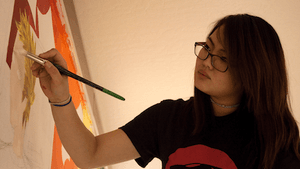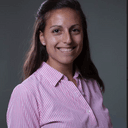Stay in the Loop
BSR publishes on a weekly schedule, with an email newsletter every Wednesday and Thursday morning. There’s no paywall, and subscribing is always free.
At the intersection of immigration and deaf culture
Penn Museum presents Mina T. Son's 'Making Noise in Silence'

What are hearing people missing by not being able to sign with deaf people? What parts of deaf culture are hard to translate? What is an accent in American Sign Language (ASL)? The Penn Museum’s Deaf Culture Program, the February installment of its Second Sunday Culture Film series that included a film screening and panel discussion, attempted to tackle these complex questions and more.
Making Noise in Silence, a 19-minute short directed by Mina T. Son (better known for her documentary Top Spin), opens with a wide shot of a bustling school hallway. It’s your classic teen scene: Fluorescent lights, rows of red lockers, and dozens of students scurrying about with books, binders, and backpacks. Locker doors squeak open and slam shut. There’s lots of laughter. The only difference is that, instead of constant chatter, there is a steady flutter of hand motions as students communicate using ASL. A bright yellow lightbulb flashes several times, the equivalent of a school bell. It’s time for class at the California School for the Deaf.
Two Korean-American students, Jeongin Mun and Min Wook Cho, came to America with their families in search of better resources and rights. Since arriving, Jeongin’s mother says she’s seen great improvement in her daughter’s overall happiness. Jeongin likes her classes and new friends, and she’s working on a school mural with hopes of one day becoming an established artist.
It took Min Wook’s family some time to appreciate that sign language is as much a part of deaf culture as speaking Korean is part of Korean culture. As they learned together, his ASL improved and he was able to focus on other things, like the school wrestling team and achieving his dream of becoming a successful businessman.
Both Jeongin and Min Wook are proud of being deaf -- and they’re proud of their many other identities, too.
Reading the room
Following the film, Penn ASL Program coordinator Jami Fisher and Deaf-Hearing Communication Centre (DHCC) executive director Neil McDevitt introduced four panelists from the deaf community: Kevin Mundy, Makoto Ikegami, Melissa Draganac-Hawk, and Alesya Starayeva. They shared their personal backgrounds and made a few connections about experiences with deafness in different places (three of the four panelists had immigrated to the United States).
Before McDevitt moved to open the floor for questions, he took a quick “poll.” By a show of hands, it became clear why there were so many different types of translators in the room. This audience was diverse: people who were deaf, people who were hearing, people born and raised in the United States, and people who immigrated here (some as recently as two weeks ago). Others were learning ASL or provide support to deaf or hard-of-hearing people, and some were simply interested in learning more about deaf culture.

The room’s positive energy suddenly became palpable -- attendees seemed more comfortable, ready to ask questions and, quite often, detour into their own experiences. A senior shared the experience of seeing, as part of a “third generation of deaf families,” improvement in acceptance of the deaf community. Another man shared his struggle of learning ASL while battling learning disabilities. A young woman who immigrated from Africa shared her fiery commitment to proving critics wrong about her “disability.”
Does deaf mean different?
A little girl approached the stage, ready to ask her question. “I was wondering...” She trailed off and paused before beginning again. “Well, have ya’ll ever felt different because, um, you’re deaf?” To her, the answer likely seemed as clear as creating a pattern with colorful play blocks: red-blue-red-blue-red-blue, hearing-deaf-hearing-deaf-hearing-deaf. Different.
McDevitt answered first. “For many people, being deaf makes you feel different from the hearing community, yes.”
“I could see the difference by how I was treated,” added Starayeva. “People would look at me as different, but I was just a deaf person.”
“I don’t know if I felt different per se,” mused Draganac-Hawk as she reflected on a time when she was the only one who used sign language in a group of 30 colleagues. “I felt like I had a gain because I knew something they didn’t know.”
The panelists thoughtfully navigated the intricacies of the complex question, offering a range of responses that ultimately circled back to the theme of the documentary: Being deaf doesn’t make someone different. Rather, it’s the intersection of many identities -- which can include deafness -- that makes individuals not just different but uniquely beautiful.
What, When, Where
Second Sunday Culture Film Series: Deaf Culture Program. February 12, 2017, at the Penn Museum, 3260 South Street, Philadelphia. (215) 898-4000 or penn.museum. The final Second Sunday event, Irish Program, is March 12, 2017.
Sign up for our newsletter
All of the week's new articles, all in one place. Sign up for the free weekly BSR newsletters, and don't miss a conversation.

 Brittany Barbato
Brittany Barbato